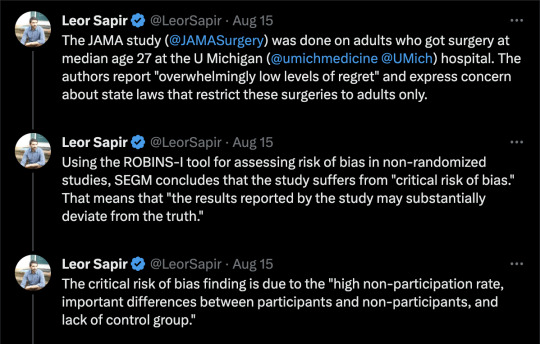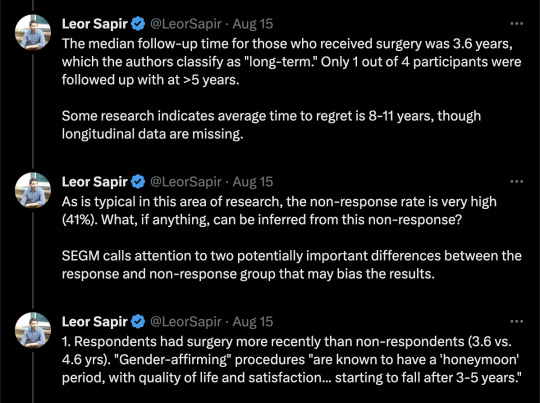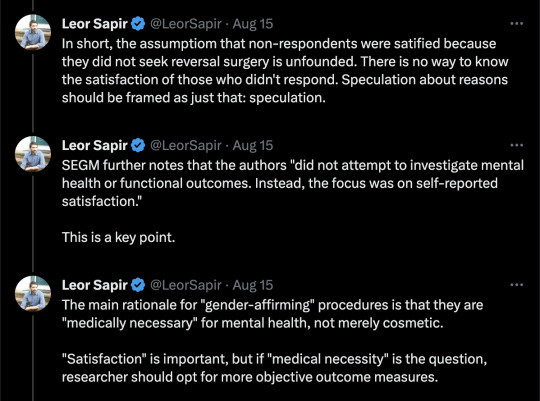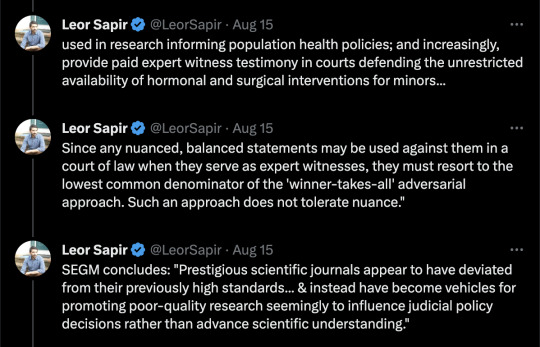#Data integrity in validation
Explore tagged Tumblr posts
Text

Learn Computer System Validation (CSV) with IGMPI’s industry-focused program. Gain expertise in regulatory compliance, FDA, GAMP 5 guidelines, and risk assessment for validated systems. Enroll now!
0 notes
Text
Ensure GMP compliance in your Indore pharmaceutical operations with Zenovel's expert Computer System Validation (CSV) services. We help you validate your critical systems for data integrity and regulatory adherence.
#data integrity#quality assurance#compliance training#Computer System Validation#regulatory requirements#GAP assessment#GMP compliance#software validation#computer validation#csv service work#validation services#GMP Computer System Validation#csv service#computer system validation gmp
0 notes
Text
The integration of artificial intelligence (AI) into medicine is profoundly transforming practices, and this raises important questions about the ability of geriatricians and general practitioners to adapt.
Here is an analysis of the issues
Growing complexity of medicine with AI
Preventive and predictive medicine
AI can analyze huge amounts of data to identify individual risks and predict disease occurrence.
This requires a deep understanding of algorithms and their interpretation.
Diagnosis
AI helps in interpreting medical images, analyzing biological data and detecting complex patterns.
This requires an ability to validate and integrate AI results into the clinical context.
Therapeutic
AI personalizes treatments based on individual patient characteristics.
This involves knowledge of AI-based therapeutic options and an ability to monitor their effectiveness.
Capacity of geriatricians and general practitioners
Continuing education
Continuing education is essential to keep physicians up to date with advances in AI and its applications in medicine.
Interdisciplinary collaboration
Collaboration with AI specialists, data scientists and other healthcare professionals is crucial for effective use of AI.
Decision support tools
AI can provide decision support tools to support physicians in interpreting data and making clinical decisions.
Specificities of geriatrics
Geriatrics, by its holistic nature, is particularly concerned with the management of multiple pathologies and fragility.
AI can be a valuable asset in synthesizing complex data and personalizing care plans.
The role of the general practitioner
The general practitioner, through regular monitoring of the patient, is on the front line to detect changes and refer to specialists.
AI can help refine its diagnosis and monitoring.
In summary
AI represents a challenge, but also an opportunity to improve the care of elderly patients.
Continuing education, interdisciplinary collaboration and the use of decision support tools are essential to enable geriatricians and general practitioners to adapt to this evolution.
General practitioners and geriatricians will have a key role in using AI as a decision-making tool.
Go further
#Adapting Doctors to AI#Algorithms#Biological data analysis#Interdisciplinary collaboration#Increasing complexity#AI-assisted diagnosis#Health data#Continuing education#Continuing medical education#Fragility#Geriatrics and AI#Medical imaging#Integration into the clinical context#Artificial Intelligence (AI) in Medicine#Clinical interpretation#Interpretation of algorithms#General medicine and AI#Predictive medicine#Preventive medicine#Decision support tools#Personalization of treatments#Polypathology#Medical decision making#Role of the general practitioner#Specificities of geriatrics#Patient monitoring#Monitoring effectiveness#Personalized therapy#Validation of AI results
0 notes
Text
Mplify - Versatile Bootstrap 4 Admin Template by Thememakker
Mplify Admin makes the development process easy and fast for you and aims to help you implement your idea in real time.
Product Highlights
Mplify is a fully professional, responsive, modern, multi-purpose, and feature-rich admin template. It can be used to create various websites, admin templates, admin dashboards, backend websites, CMS, CRM, blogs, business websites, timelines, and portfolios. This versatility makes it an ideal choice for developers looking to build functional and aesthetically pleasing web applications efficiently.

Key Features
Bootstrap 4.3.1: Ensures compatibility and modern design standards.
jQuery 3.3.1: Offers extensive plugins and support.
Built-in SCSS: Provides more flexibility and control over styles.
Light & Dark Full Support: Allows users to switch between light and dark themes.
RTL Full Support: Right-to-left language support for global accessibility.
W3C Validate Code: Ensures high coding standards and practices.
Mobile and Tablet Friendly: Responsive design for all devices.
Treeview: For hierarchical data display.
Drag & Drop Upload: Simplifies file uploading processes.
Image Cropping: Integrated tools for editing images.
Summernote: Rich text editor integration.
Markdown: Support for markdown formatting.
Beautiful Inbox Interface: User-friendly email management.
User-Friendly Chat App: Built-in chat application.
Scrum & Kanban Taskboard: Task management tools.
Add Events to Your Calendar: Event management capabilities.
File Manager: Efficient file organization and management.
Blogging: Tools to manage and create blog posts.
Testimonials: Features to showcase user testimonials.
Maintenance: Tools to manage and schedule maintenance.
Team Board: Collaboration tools for team management.
Search Result: Enhanced search functionalities.
Beautiful Pricing: Elegant pricing tables and plans.
Contact List & Grid: Efficient contact management.
User Profile: Customizable user profiles.
Extended Forms: Advanced form functionalities.
Clean Widgets: A variety of clean, modern widgets.
Technical Specifications
Bootstrap 4.3.1
Bootstrap 4.3.1 is a powerful front-end framework for faster and easier web development. It includes HTML and CSS-based design templates for typography, forms, buttons, tables, navigation, modals, image carousels, and many other interface components, as well as optional JavaScript plugins. Mplify leverages Bootstrap 4.3.1 to ensure a consistent and responsive design across all devices.
jQuery 3.3.1
jQuery is a fast, small, and feature-rich JavaScript library. It makes things like HTML document traversal and manipulation, event handling, and animation much simpler with an easy-to-use custom API integration that works across a multitude of browsers. Mplify includes jQuery 3.3.1 to provide enhanced functionality and interactivity to your applications.
Built-in SCSS
SCSS is a preprocessor scripting language that is interpreted or compiled into CSS. It allows you to use variables, nested rules, mixins, inline imports, and more, all with a fully CSS-compatible syntax. With SCSS, Mplify offers a more powerful and flexible way to manage styles.
Light & Dark Full Support
Mplify comes with built-in support for light and dark themes, allowing users to switch between these modes based on their preferences. This feature enhances user experience and accessibility, especially in different lighting conditions.

RTL Full Support
For developers targeting global audiences, Mplify provides full right-to-left (RTL) language support. This feature ensures that languages like Arabic, Hebrew, and Persian are properly displayed, making the template versatile and inclusive.
W3C Validate Code
The World Wide Web Consortium (W3C) sets the standards for web development. Mplify adheres to W3C's coding standards, ensuring that the template is built with clean, valid code, which improves browser compatibility, SEO, and overall performance.
Mobile and Tablet Friendly
In today's mobile-first world, having a responsive design is crucial. Mplify is designed to be fully responsive, ensuring that your mobile application looks great and functions seamlessly on all devices, including desktops, tablets, and smartphones.
Applications
Mplify’s versatile design and feature set make it suitable for a wide range of applications across various industries. Here are some key applications:
Admin Dashboards
Mplify provides a robust framework for building admin dashboards. With its extensive set of UI components, charts, forms, and tables, you can create comprehensive dashboards that provide valuable insights and data visualization.
CMS (Content Management Systems)
With features like blogging, file management, and user profile management, Mplify can be used to build powerful CMS platforms. Its clean widgets and beautiful interface ensure that the content management experience is both efficient and enjoyable.
CRM (Customer Relationship Management)
Mplify’s built-in tools for managing contacts, scheduling events, and maintaining communication through a chat app make it an excellent choice for developing CRM systems. These features help businesses manage customer interactions and data effectively.
Business Websites
The multi-purpose nature of Mplify allows it to be used for various business websites. Whether you need a portfolio, a blog, or a corporate website, Mplify provides the necessary tools and components to create a professional online presence.
Blogging Platforms
With integrated tools like Summernote for rich text editing and Markdown support, Mplify is ideal for creating blogging platforms. The beautiful inbox interface and testimonial features enhance the blogging experience, making it easy to manage and publish content.

Benefits
Easy and Fast Development
Mplify is designed to streamline the development process. With its pre-built components and templates, you can quickly assemble functional and aesthetically pleasing applications. This reduces development time and costs, allowing you to focus on implementing your ideas in real time.
Professional and Modern Design
Mplify offers a clean, modern design that is both professional and user-friendly. The template includes a variety of customizable widgets and components that adhere to the latest design standards, ensuring your application looks polished and up-to-date.
Comprehensive Feature Set
From task management tools like Scrum and Kanban boards to extensive form functionalities, Mplify provides a wide range of features that cater to various needs. This comprehensive feature set makes it a versatile solution for different types of projects.
Responsive and Mobile-Friendly
With Mplify, you can ensure that your application is accessible on all devices. Its responsive design adapts to different screen sizes, providing a seamless user experience on desktops, tablets, and smartphones.
Global Accessibility
Mplify’s RTL support and multi-language capabilities make it suitable for global applications. This feature ensures that your application can cater to users from different regions, enhancing its reach and usability.
Regular Updates and Support
When you purchase a license for Mplify, you receive all future updates for free. This ensures that your application remains up-to-date with the latest features and improvements. Additionally, Mplify provides excellent customer support to assist with any issues or queries.
Challenges and Limitations
Learning Curve
While Mplify is designed to be user-friendly, there may be a learning curve for beginners who are not familiar with Bootstrap or jQuery. However, comprehensive documentation and community support can help mitigate this challenge.
Customization
Although Mplify offers a wide range of customization options, extensive customization may require advanced knowledge of SCSS and JavaScript. This could be a limitation for developers who are not well-versed in these technologies.

Performance
As with any feature-rich template, there is a potential for performance issues if too many components and plugins are used simultaneously. It is important to optimize the application and selectively use features to maintain optimal performance.
Latest Innovations
Enhanced UI Components
Mplify continues to evolve with regular updates that introduce new and improved UI components. These enhancements ensure that your application remains modern and functional.
Advanced-Data Visualization
Recent updates have focused on improving data visualization capabilities. With enhanced charting tools and interactive elements, Mplify allows for more dynamic and engaging data presentation.
Integration with New Technologies
Mplify is continuously updated to integrate with the latest web technologies. This ensures compatibility with new frameworks and libraries, providing developers with more tools to build advanced applications.
Future Prospects
AI and Machine Learning Integration
The future of Mplify may include integration with AI and machine learning tools. This would enable developers to build more intelligent and automated applications, enhancing user experience and functionality.
Expanded Plugin Support
As the web development landscape evolves, Mplify is likely to expand its plugin support. This will provide developers with more options for extending the functionality of their applications.
Improved Accessibility Features
Mplify is expected to continue enhancing its accessibility features. This includes better support for assistive technologies and compliance with accessibility standards, ensuring that applications built with Mplify are inclusive for all users.
Comparative Analysis
Versus Other Bootstrap Templates
When compared to other Bootstrap templates, Mplify stands out due to its comprehensive feature set, modern design, and extensive customization options. While other templates may offer similar components, Mplify's unique features like RTL support and advanced task management tools give it an edge.
Versus Custom Development
Opting for a pre-built template like Mplify can significantly reduce development time and costs compared to custom web development. While custom development offers more flexibility, Mplify provides a robust foundation that can be easily customized to meet specific needs.
User Guides and Tutorials
Getting Started with Mplify
Installation: Download and install Mplify from the official website or marketplace.
Configuration: Configure the template settings according to your project requirements.
Customization: Use the built-in SCSS files to customize the styles and appearance.
Integration: Integrate Mplify with your backend systems and databases.
Deployment: Deploy your application on your preferred hosting platform.
Advanced Customization Techniques
SCSS Variables: Use SCSS variables to easily change colors, fonts, and other styles.
JavaScript Customization: Extend the functionality by adding custom JavaScript code.
Component Modification: Modify existing components or create new ones to meet specific needs.
Performance Optimization: Optimize the performance by minifying CSS and JavaScript files, and selectively loading components.
Conclusion
Mplify is a powerful, versatile, and user-friendly Bootstrap 4 admin dashboard template. It offers a wide range of features and customization options, making it suitable for various applications, from admin dashboards to business websites. With its modern design, responsive layout, and extensive documentation, Mplify simplifies the development process, allowing developers to implement their ideas in real time efficiently.
Whether you are building a CMS, CRM, or a personal blog, Mplify provides the tools and flexibility needed to create a professional and functional web application. Its ongoing updates and support ensure that your projects remain current and compatible with the latest web technologies.
#Mplify Admin#Bootstrap 4.3.1#jQuery 3.3.1#SCSS#Light & Dark Theme#RTL Support#W3C Validation#Responsive Design#Admin Template#Admin Dashboard#CMS#CRM#Blogging#Business Websites#Web Development#UI Components#Data Visualization#AI Integration#Machine Learning#Accessibility Features#Task Management#File Management#Rich Text Editor#Markdown Support#User Profiles#Performance Optimization#Web Technologies#Custom Development#Web Application Development#Front-end Framework
0 notes
Text
Mastering Microsoft Purview Workflow: Revolutionize Your Data Governance
Dive into the world of Microsoft Purview Workflow, a key to mastering data governance. Learn how it automates data integrity, compliance, and collaboration, revolutionizing your organization's data management practices for unparalleled efficiency and sec

View On WordPress
#Asset Attribute Management#Audit Trail Documentation#Automated Data Validation#Change Management Processes#Compliance Strategies#Data Asset Updates#Data Cataloging Techniques#Data Governance#Data Integrity Assurance#Data Management Policies#Data Quality Management#Data Stewardship Practices#Data Update Escalation#Metadata Management#Microsoft Purview#Organizational Efficiency#Regulatory Compliance#Stakeholder Notification Systems#Workflow Automation
0 notes
Text
The Power of Automated Data Lineage: Validating Data Pipelines with Confidence
Introduction In today’s data-driven world, organizations rely on data pipelines to collect, process, and deliver data for crucial business decisions. However, ensuring the accuracy and reliability of these pipelines can be a daunting task. This is where automated data lineage comes into play, offering a solution to validate data pipelines with confidence. In this blog post, we will explore the…

View On WordPress
#data engineering#data integrity#data lineage#data pipeline#data quality#impact analysis#root cause analysis#validation
0 notes
Note
As a leader, are there any MBTI types you dislike leading or having on your team?
I dislike people who are incompetent, unreliable, and lack integrity regardless of MBTI type.
In general, though, all the types are pains in my ass in their own special ways:
High Te (ENTJ, ESTJ, INTJ, ISTJ)
Doesn't play well with others; I constantly need to fix the feelings they hurt and cushion their communication so they don't end up pariahs that no one wants to work with.
Bulldozes through people to get things done, requires a 'pause' button and calm hand because they get frustrated easily with things going slow. Sometimes you need to go slow to go far.
Struggles with 'team building' and 'that touchy feely shit'; highly transactional.
(ESTJ & ISTJ) "Mr./Mrs. No", too quick to shoot down ambitious but unproven ideas because it hasn't worked before or will take a lot of effort to accomplish.
(ENTJ & INTJ) Convinced their weird 'reads' into things are correct despite evidence to the contrary staring them right in the face. Not everything has a deeper and hidden meaning.
High Fe (ENFJ, ESFJ, INFJ, ISFJ)
Whines a lot, about everything, and requires a lot of time and energy listening to their feelings.
Needs external validation and requires regular praise/feedback or else they'll assume you're mad at them. The sulking and internal spiraling is a bit much.
Avoids confrontation, mirrors other people's opinions, and requires pushing and pushing to get them to reveal their true opinions and stand their ground. Uses stronger people around them to represent their views (human shields).
Tendency to gossip, can't stay out of people's business and spreads misinformation like wildfire.
A company isn't a family-- not everyone wants to attend your weekend team potluck.
High Ti (INTP, ISTP, ENTP, ESTP)
Always causes more chaos than clarity, requires a ton of work to fix the confusion bombs they drop into groups.
Debates endlessly, needs everything personally spoonfed and explained to them in exhausting detail until they're satisfied or else they can't accept the plan and they won't commit. This slows down everything for everyone.
Flaky, can't hit a deadline to save their lives. Requires check-ins and external pressure (group work) to hit milestones.
(ESTP & ISTP) Out of sight doesn't mean out of mind. There are things that can happen later in the future that we should plan for now.
(ENTP & INTP) Just because you read a book about some obscure topic once doesn't make you an expert. Books =/= reality. Don't be a backseat driver-- do it and prove it.
High Fi (INFP, ISFP, ENFP, ESFP)
Half asses everything they don't enjoy doing because this isn't their passion and their parents made them take this job when they really wanted to do art/music/acting something something.
Struggles to work with people who hold different political views than them; self-segregates.
Terrible at taking constructive criticism and feedback, gets defensive, shuts down, and takes everything personally.
(ENFP & INFP) Highly idealistic to the point they're blind to data that tells them the hard and cold truth, they struggle to manage practical things like resources, time, money.
(ESFP & ISFP) Out of sight doesn't mean out of mind. There are things that can happen later in the future that we should plan for now.
#mbti#myers briggs#psychology#typology#entp#intp#entj#intj#infp#infj#enfp#isfp#esfp#enfj#isfj#esfj#estp#istp#estj#istj#faq#leadership#team
205 notes
·
View notes
Text
NEWS FLASH ⚡️
Six-year follow-up of the treatment of patients with dissociative disorders study
In the attached study, 12.8% of patients reached final fusion, and 12.8% of patients were considered resolved with functional multiplicity.
61.7% did not complete therapy.
A portion of these patients are dead or missing. A moment of silence for those lost. Never forget the suicide rates in our community.
This article is from 2017, and the ISSTD guidelines are from 2011. Both say that functional multiplicity is a valid treatment option.
The authors of the 3 phase treatment talk about how it's okay to stop at functional multiplicity.
Don't let anyone tell you otherwise.
Treatment goals are personal, some of you need to mind your own goddamn business
Further reading:
Critiquing the Requirement of Oneness - Kymbra Clayton
CDS UK Treatment
A survey of practices and recommended treatment interventions among expert therapists treating patients with dissociative identity disorder and dissociative disorder not otherwise specified.
There exists no published, empirical data demonstrating that direct intervention with self states worsens DID, although there is clinical literature that describes negative outcomes of inappropriate interventions with self states (Kluft, 1989a).
Whether or not unification takes place or the extent to which it endures, most severely dissociative patients, even those in the lowest functioning group, can improve during specialized focuses on dissociation.

[X]
CTAD Clinic, a multi part series on integration, fusion, and personal choices
#you all make it hard to stop why has no one thrown this in their face yet#I'm not going to be here forever#syscourse#not syscourse#pro syscourse conversation#sysconversation#did#osdd#system safe#debunk#plurality#did treatment#osddid#osdid#pro endo
83 notes
·
View notes
Text

VOX TRANSMISSION // OUTBOUND ORIGIN: DARGONUS // RED-NET LOCKED AUTHENTICATION: Magos Pasqal Haneumann DIRECTIVE ENTITY: Codename ‘OMEN’ TIMESTAMP // 17.42 STANDARD INTENDED RECEIVER: Lucin’s Breath – Sub-Orbital Holdfast Inbound signal acquired — latency: 12.0s. Line stability: nominal.
[Data-packet outbound: verified] [Resonance: high-fidelity] // Logged Vox-Fragment: SINGULUM-LAMB.06 // Unlock Sequence: Rite 774-A // Cipher Substring: A-S-H-3-S // Authorization Node: OMN-991-HANEUMANN
VOX CHANNEL OPEN: COMMENCING…
Confirmed: Warrant-bearers en route. Vessels designate: high-charter, legacy-grade—purity seals validated. Convergence authorized under direct invocation by Entity Codename: 'OMEN'. Tactical coordinates in queue via encrypted burst-transmission: Magenta-Priority. Audio-fragment contains augmetic overlay—predictive resonance detected. Sanctioned: interpret with due reverence. Transmission integrity: verified by Magos Haneumann. Vox closed under seal-pattern: TRIA-NULL-991.

LAYMAN FILE ATTACHED…
#rogue trader#warhammer 40k#rogue trader gift exchange#rogue trader crpg#pasqal haneumann#von valancius#heinrix van calox#warhammer rogue trader#marazhai aezyrraesh#Spotify
56 notes
·
View notes
Text
Transparency in AI-use within Fandom Culture (or: how to be upfront when you risk getting shot down)
Since writing my original post, it’s been really cool hearing from fellow writers who use AI as a support tool to help them keep writing despite their mental health struggles, dyslexia, or in my case, depression.
There are valid and justified ethical concerns to do with the use of AI itself, such as the issue of consent, which I’ve tried to discuss elsewhere. But I wanted to write this post with fanfic writers and fandom in mind. There are some people like me who are already using it as a tool for writing, and so I wanted to look at how this can be done transparently and respectfully, and so that readers know and trust what they are reading.
Context
I’ve been using generative AI as a tool for over 18 months - initially as part of my work in the charity sector, and then later in writing fanfic. When my little one is older, I hope to go back into the field of Public Health, where I'll be using it as a tool to help analyse and synthesise qualitative and quantitative data (among a ton of other things), in order to help address health inequalities in the UK.
Perhaps naively, I didn’t fully understand the ethical concerns to begin with, particularly with regards to fanfic, and by the time I started realising there were issues it felt like there were no safe spaces in which to ask people about it.
Fear and loathing in Fandom Spaces
It seems like there’s this environment of fear and shame at the moment (the posts and reblogs that I see on my dash come across as absolutist, derogatory and even abusive towards anyone using AI for any reason), and I think this is why a lot of writers don’t want to be open about their use of AI, especially if they are in a small fandom and are worried what their mutuals or fellow writers and readers might think of them, or how they might get excluded from certain fandom spaces.
I’ve already seen some writing events that have a strict ‘no AI’ policy and whose language reflects the anti-AI sentiments above, so I can see why some people might join these events but not want to disclose their use of AI. (Having said that, it’s not okay for people to enter an exchange undercover that has clear rules against AI, and to just stay silent and use it anyway. If an event or community has set boundaries, those need to be honoured and respected. We need to have integrity as AI users, and as a friend pointed out, respect has to go both ways).
Given that writers use generative AI for different reasons and in different ways, I think there needs to be a willingness to have an open and thoughtful conversation to reflect this spectrum of use. I’m just thinking off the top of my head – maybe a writing event could have these types of guidelines:
Whump-Mania Writing Event: AI Use Guidelines* 1. Be transparent. If you used AI (for ideas, research, grammar, etc.), mention it in your author notes. 2. Your words come first. AI can help but the story should be yours. No fully AI-written fic, please. 3. No purity tests. This is about honesty, not exclusion. Let’s keep the space kind and open.
(*For transparency: I asked chatgpt to come up with those guidelines, then I edited them. Also I made up the phrase Whump-Mania. As far as I know, there is no writing event called that, but it would be awesome if there was).
This is just a starter for ten, and would obviously need to be a lot more nuanced and thoughtful, especially in the context of gift exchanges, as people have varying degrees of comfort when it comes to accepting a gift where AI has been used in any aspect of writing it. (Personally, I’ve taken part in Secret Santa fic exchanges, and whilst I’d be fine with someone gifting me a work where they used AI to proof-read it, I would probably be a bit peeved if I found out they’d just taken my prompt, fed it into chatGPT and then gifted me that work).
So maybe some kind of tick box – “this is the level of AI-use I’m comfortable receiving” – ranging from ‘none’ to ‘fully-generated by AI’, with options in between. There would need a proper discussion, but I think it would be a worthwhile one so that these types of exchanges could remain inclusive.
(Just to point out again though, it’s up to the organiser at the end of the day - it’s their event and their hard work and time running it. If you’re unsure about their AI stance, it might be worth politely contacting them just to see what level of AI-use they might consider accepting, and sharing how you would use it - for example for spellchecking or research - and then politely accepting their decision without arguing or vagueposting about it, because they’re people too and it’s about remaining kind and respectful in this whole wider discussion, even if you feel hurt or misunderstood).
Tagging (or: my tag is not your tag)
So with regards to tagging – at the moment, I feel like tagging AI on AO3 isn’t a good option because there’s only one tag, “Created using generative AI”, which doesn’t distinguish between fully-AI generated works and one of my fics where I write every word and then use AI afterwards as a final spell-check before posting.
Also there’s a post going around on Tumblr at the moment that’s a screencap of the AO3 tag and listed works, and shaming people who have used the tag (although no individuals have been named). It’s got over 70,000 notes and it honestly feels a little scary.
Transparency can only work in an environment where people feel safe to speak (and tag), knowing they’re not going to get subjected to shame, hate and abuse. (Sorry for the jumpscare bold type. Just think that this is important to highlight).
Personal AI Disclaimer Use: (or, Me, Myself and AI)
So what I’m choosing to do is put an AI disclaimer use on my AO3 profile which gives me a voice to describe my own use of AI as well as advocating for more ethical AI. Then I’m putting a note in the author’s note of my fic saying “this fic was created in accordance with my personal AI disclaimer use, specifically - ” and then sharing how, e.g for research into mining duridium, a fictional ore in Star Trek.
This is the best I can come up with at the moment but I’d genuinely like to hear what other writers and readers think about it and if you have any suggestions – feel free to use the ask box (the anon function is on) or DM me. This is also why I’ve tagged this post with the fandom I’m currently writing in, for transparency and to get feedback.
It might be that because I use generative AI full stop, in any capacity, this means you’re not able to engage with my writing any more. I’m sorry for this but I do understand why you might feel like that. I appreciate your candour and wish you the Vulcan blessing of peace and long life and prospering in all you do.
Other people are understandably cautious about reading my fics going forward, and so that’s why I want to be transparent about the way I use AI, so that people can trust what they’re reading, and to make an informed decision about whether or not to engage with the story.
In conclusion
I think we need to be having this conversation out in the open. AI can be guilty of suppressing creativity, but as fans, we can also suppress creativity by creating environments that feel exclusionary or even unsafe, where people feel reluctant to speak up, share or create.
I know this topic of AI is a raw and emotive one, and I’m sorry if anything I’ve written has come across as minimising the issue or anyone’s feelings, that wasn’t my intention.
(This post is a reworking of one of my reblog answers after posting Reflections of a Fanfic Writer: What I Think About When I Think About Writing. It is a companion piece to Confessions of a Fanfic Writer: How and Why I Write with AI and I used chatgpt afterwards to double-check for typos because they wind me up).
#fandom#fanfic#writing with AI#star trek enterprise#artificial intelligence#writing process#writers#writing#ai discourse#open discussion welcome#ao3
20 notes
·
View notes
Text
TikTok Ban: A Little Too Convenient?
The TikTok ban saga has been wild to watch unfold, but honestly, the closer you look, the more questions arise. Between members of Congress holding Meta stock and Facebook’s sudden interest in integrating TikTok accounts, it feels less like a genuine privacy concern and more like a potential power play. Let’s break this down.
Congress Loves Meta—And Hates TikTok Did you know that several members of Congress own Meta stock? A 2023 analysis revealed that lawmakers with financial interests in Meta, Alphabet, and Snap could stand to benefit if TikTok faces a U.S. ban. This raises potential conflicts of interest, especially when these same lawmakers are involved in crafting legislation that directly affects TikTok.
Meanwhile, Meta, despite its long history of privacy violations (remember Cambridge Analytica?), doesn’t seem to face the same scrutiny. It’s hard not to wonder why Congress is suddenly so concerned about user privacy when it comes to TikTok but continues to give Meta a pass.
Meta’s Sudden Interest in TikTok Integration With TikTok under threat of a U.S. ban, Facebook recently added features allowing TikTok users to link their accounts to their profiles. While this feature aligns with broader trends of social media integration, the timing feels a little too coincidental. It suggests a strategic move by Meta to retain users who might migrate away from TikTok or prepare for an influx of creators seeking alternative platforms.
Even If Trump “Saves” TikTok, I’m Not Buying It Let’s say Trump swoops in and “saves” TikTok at the last minute. I still have serious concerns about what that actually means. Trump is transactional—he doesn’t do anything unless it benefits him or his allies. If TikTok is “saved,” I can’t help but wonder:
Does it get sold—in name only—to a U.S. company like Meta, keeping the same issues but with a different logo?
Does it stick around but get neutered, suppressing content like other corporate-owned platforms?
Or does it become a tool for pushing American propaganda, especially with initiatives like Project 2025 on the horizon?
These are just questions, but I think they’re valid ones. If TikTok survives under Trump’s “protection,” it’s unlikely to remain the platform we know today.
Is This Really About Privacy? The ban is framed as a response to concerns over data privacy and national security, but critics argue it might be more about corporate competition and information control. TikTok’s algorithm has surpassed its competitors in engagement and reach, making it a significant threat to U.S.-based platforms like Meta.
It’s worth noting that many social media platforms collect similar levels of user data, and the difference often lies in who owns the company. In TikTok’s case, its ties to China have made it a target for U.S. lawmakers.
The Bigger Picture Regardless of what happens with TikTok, the implications of this ban extend far beyond one app. It sets a precedent for government control over digital platforms, raising questions about freedom of expression, competition, and corporate influence.
If we’re not questioning these decisions now, we risk handing over even more control to a small group of powerful entities—whether they’re corporations, governments, or both.
24 notes
·
View notes
Text
The integration of artificial intelligence (AI) into medicine is profoundly transforming practices, and this raises important questions about the ability of geriatricians and general practitioners to adapt.
Here is an analysis of the issues
Growing complexity of medicine with AI
Preventive and predictive medicine
AI can analyze huge amounts of data to identify individual risks and predict disease occurrence.
This requires a deep understanding of algorithms and their interpretation.
Diagnosis
AI helps in interpreting medical images, analyzing biological data and detecting complex patterns.
This requires an ability to validate and integrate AI results into the clinical context.
Therapeutic
AI personalizes treatments based on individual patient characteristics.
This involves knowledge of AI-based therapeutic options and an ability to monitor their effectiveness.
Capacity of geriatricians and general practitioners
Continuing education
Continuing education is essential to keep physicians up to date with advances in AI and its applications in medicine.
Interdisciplinary collaboration
Collaboration with AI specialists, data scientists and other healthcare professionals is crucial for effective use of AI.
Decision support tools
AI can provide decision support tools to support physicians in interpreting data and making clinical decisions.
Specificities of geriatrics
Geriatrics, by its holistic nature, is particularly concerned with the management of multiple pathologies and fragility.
AI can be a valuable asset in synthesizing complex data and personalizing care plans.
The role of the general practitioner
The general practitioner, through regular monitoring of the patient, is on the front line to detect changes and refer to specialists.
AI can help refine its diagnosis and monitoring.
In summary
AI represents a challenge, but also an opportunity to improve the care of elderly patients.
Continuing education, interdisciplinary collaboration and the use of decision support tools are essential to enable geriatricians and general practitioners to adapt to this evolution.
General practitioners and geriatricians will have a key role in using AI as a decision-making tool.
Go further
#Adapting Doctors to AI#Algorithms#Biological data analysis#Interdisciplinary collaboration#Increasing complexity#AI-assisted diagnosis#Health data#Continuing education#Continuing medical education#Fragility#Geriatrics and AI#Medical imaging#Integration into the clinical context#Artificial Intelligence (AI) in Medicine#Clinical interpretation#Interpretation of algorithms#General medicine and AI#Predictive medicine#Preventive medicine#Decision support tools#Personalization of treatments#Polypathology#Medical decision making#Role of the general practitioner#Specificities of geriatrics#Patient monitoring#Monitoring effectiveness#Personalized therapy#Validation of AI results
0 notes
Text
5 Challenges of AI in Healthcare
New Post has been published on https://thedigitalinsider.com/5-challenges-of-ai-in-healthcare/
5 Challenges of AI in Healthcare
Imagine a world where your smartwatch not only tracks your steps but also predicts a heart attack before it happens. It’s closer to reality than you think.
Artificial intelligence (AI) integration in healthcare has begun, unlocking many use cases for healthcare providers and patients. The AI healthcare software and hardware market is expected to surpass $34 billion by 2025 globally.
Among the technology and processes indicative of these investments in healthcare include:
Robotic nurses to aid surgeons.
Wearables for real-time health monitoring.
Medical AI chatbots for enhanced self-care.
Predictive diagnosis based on existing health symptoms.
However, these applications also come with complex challenges. This blog will explore the five challenges in implementing AI in healthcare, their solutions, and their benefits.
Challenges of Using AI in Healthcare
Physicians, doctors, nurses, and other healthcare providers face many challenges integrating AI into their workflows, from displacement of human labor to data quality issues.
1. Displacement of Human Employees
There is a growing concern that AI could replace healthcare professionals, including job displacement, an outdated skillset, and mental and financial hardships. This potential shift may deter medical groups from adopting AI, causing them to forego many benefits.
The challenge lies in balancing the integration of AI for routine tasks and retaining human expertise for complex patient care, where empathy and critical thinking are irreplaceable.
2. Ethical and Privacy Issues
Obtaining informed consent from patients on how AI systems will use their data can be complex, especially when the public does not fully understand the underlying logic. Some providers might also disregard ethics and use patient data without permission.
Additionally, biases in training data could result in unequal treatment suggestions or misdiagnosis. This discrepancy can disproportionately affect vulnerable groups.
For example, an algorithm that predicts which patients need more intensive care based on healthcare costs rather than actual illness. This incorrectly attributed a lower disease burden to black people.
Furthermore, AI’s ability to identify individuals through large amounts of genome data, even when personal identifiers are removed, poses a risk to patient confidentiality.
3. Lack of Digital Training and Adoption Barriers
A major problem is that medical students receive insufficient training on AI tools and theory. This unpreparedness makes adopting AI difficult during their internships and work.
Another significant barrier is the reluctance of some individuals to embrace digital technologies. Many people still prefer traditional, in-person consultations due to multiple reasons, such as:
The relatable nature of human interactions.
Uniqueness neglect by AI.
The higher perceived value of human doctors, etc.
This resistance is often compounded by a general lack of awareness about AI and its potential benefits, particularly in developing countries.
4. Professional Liabilities
The use of AI systems in decision-making introduces new professional liabilities for healthcare providers, raising questions about ownership if AI initiatives are ineffective. For example, doctors can defer treatment plans to AI without taking responsibility for failed patient examinations.
Furthermore, while machine learning (ML) algorithms can offer personalized treatment recommendations, the lack of transparency in these algorithms complicates individual accountability.
Additionally, reliance on AI could lead to complacency among healthcare professionals, who might defer to computerized decisions without applying their clinical judgment.
5. Interoperability Problems and Data Quality Issues
Data from different sources can often fail to integrate seamlessly. Inconsistency in data formats across systems makes it difficult to access and process information efficiently, creating information silos.
Moreover, poor data quality—such as incomplete or inaccurate records—can lead to flawed AI analysis, ultimately compromising patient care.
Considering these challenges, how can healthcare organizations leverage the full potential of AI?
Solutions to Healthcare AI Problems
Solving the challenges introduced by AI involves a top-down approach. It begins with ensuring that data analysts thoroughly vet datasets used to train AI algorithms to eliminate biases and low-quality data. Transparency with patients regarding AI’s role in their treatment is also crucial to increase adoption.
An example is the Mayo Clinic, which used an algorithm that analyzed over 60,000 images to detect pre-cancerous signs. The algorithm’s accuracy was 91% compared to a human expert’s.
Apart from fixing old datasets, health regulatory bodies, such as the European Medicines Agency (EMA), must collect new, error-free data representing diverse populations to enhance accuracy. OpenAPS is an example of an initiative to create an inclusive open-source collection of systems to treat type 1 diabetes accurately.
Additionally, hospitals should enhance training and education for healthcare professionals. Educational authorities can also extend this specialized training to universities to prepare future practitioners.
This initiative will ensure familiarity with and expertise in AI tools and reduce resistance to their adoption in a professional setting. For example, Intuitive Surgical Ltd’s investment in the da Vinci system has helped doctors in over 5 million surgeries.
Investing in modern data integration tools, such as Astera and Fivetran, with built-in data quality features will also help. These tools remove siloed data and improve interoperability. They also enable data validation to ensure AI algorithms have clean data to analyze.
To effectively integrate AI systems into healthcare, medical institutions must balance leveraging AI and preserving human expertise. Adopting hybrid approaches like human-in-the-loop (HITL) models can help alleviate fears of job displacement. This approach will also ease patient concerns about AI involvement while allowing workers to improve productivity.
And, what are the benefits of successful AI integration within healthcare?
Benefits of AI in Healthcare
AI provides many benefits in the healthcare industry, including improved diagnosis and higher work efficiency:
1. Enhanced Diagnostic Accuracy
AI is transforming diagnostic processes by rapidly analyzing medical images, lab results, and patient data with remarkable precision. This ability to process large amounts of information quickly leads to early, potentially more accurate diagnoses, improving disease management.
2. Personalized Treatment Plans
AI-powered deep learning algorithms can process extensive datasets to create personalized treatment plans tailored to individual patients. This customization improves the efficacy of treatments and minimizes side effects by addressing each patient’s specific needs based on extensive sample data.
3. Operational Efficiency
By automating administrative tasks such as scheduling appointments and billing, AI allows healthcare providers to spend more time and effort on direct patient care. This shift reduces the burden of routine tasks, cuts costs, streamlines operations, and improves overall efficiency.
4. Improved Patient Monitoring
AI-powered tools, including wearable devices, offer continuous patient monitoring, providing real-time alerts and insights. For example, these devices can alert medical services in case of an unusually high heartbeat, which could indicate a physical injury or heart condition.
This proactive approach enables healthcare providers to respond swiftly to changes in a patient’s condition, improving disease management and overall patient care.
Looking Ahead
Emerging technologies, like virtual reality (VR) in medicine, will play a critical role. Many healthcare tasks, from diagnostics to treatment, will be AI-powered, enhancing access to care patient outcomes.
However, healthcare authorities must balance AI’s benefits and challenges to ensure ethical and effective integration into patient care. This will transform the healthcare delivery systems in the long term.
Explore Unite.ai for more resources on AI and healthcare.
#000#ai#AI chatbots#AI in healthcare#AI integration#AI systems#ai tools#AI-powered#alerts#algorithm#Algorithms#Analysis#applications#approach#artifical intelligence#artificial#Artificial Intelligence#awareness#barrier#billion#Blog#challenge#chatbots#continuous#data#Data Integration#data integration tools#data quality#data validation#datasets
1 note
·
View note
Text
CONFIDENTIAL ETHICS REPORT
DRC, Internal Affairs Division, Ethics & Compliance Command
To: Operations Oversight Committee
From: Chief Operating Officer [REDACTED], Ethics Compliance Officer
Date: [REDACTED]
Subject: Comprehensive Review of the Ethics Training Program
Executive Summary
This report reviews the current Ethics Training Program (ETP) across all operational paternity compounds. The program, originally designed to instill a sense of moral discipline, professional integrity, and emotional detachment, has encountered significant challenges in achieving its objectives.
Despite mandatory completion rates of [REDACTED]%, on-the-ground observations indicate that ethical lapses remain persistent. This review aims to identify existing weaknesses in the training framework and propose enhancements to ensure staff uphold DRC values of compliance, efficiency, and emotional neutrality.
Key Findings
I. Declining Ethical Compliance
Despite repeated training modules emphasizing professional distance, a recent audit found:
[REDACTED]% of staff exhibited unnecessary physical engagement with surrogates, ranging from [REDACTED] to unauthorized [REDACTED].
[REDACTED]% of handlers reported experiencing "existential guilt episodes" after prolonged surrogate interactions.
[REDACTED]% of new recruits required retraining after expressing---
[SYSTEM RESPONSE]
[AUTHENTICATION PROTOCOL ENGAGED]
[SECURITY LEVEL]: [HIGH]
[USER IDENTIFICATION]: [Executive Level-01A]
[CREDENTIAL AUTHENTICATION IN PROGRESS...]
[ENTER PASSWORD]: [***************]
[PROCESSING INPUT...]
[VALIDATING PASSWORD...]
[█░░░░░░░░░░░░] 10%
[███░░░░░░░░░░] 30%
[███████░░░░░░] 60%
[███████████░░] 90%
[█████████████] 100%
[PASSWORD ACCEPTED]
[ACCESS GRANTED]: [HIGH CLEARANCE MODE ACTIVATED]
[SECURITY OVERRIDES]: [Enabled]
[REDACTED DATA]: [Unlocked]
II. Inappropriate Surrogate Relations
Despite the introduction of the Male Paternity Regulation and Evaluation Guide (MPREG), security audits and surveillance reviews have uncovered multiple incidents in which staff have failed to maintain appropriate boundaries with surrogates. These violations undermine the core principles of surrogate management and jeopardize operational efficiency by fostering unhealthy emotional dependencies and encouraging surrogate non-compliance.
Documented Breaches:
Unauthorized Physical Contact
Multiple reports indicate staff members engaging in “excessive belly-rubbing” under the guise of "medical check-ups," with some employees spending prolonged periods tracing stretch marks and remarking on the “impressive elasticity” of surrogate skin.
In one instance, an employee was observed resting his forehead against a surrogate's abdomen, citing an attempt to "listen for movement patterns."
Security footage captured a handler providing “unsanctioned belly massages” of seven late-term surrogates (immobile due to the size of pregnancies), commenting on the "firmness" and "size" even when surrogates protested the contact.
Surrogate Statement
"I kept telling him it wasn't necessary, but he just kept running his hands over my belly, saying he was 'checking for ripeness.' It felt weird—like he wasn’t even listening to me. I couldn’t move much, and he took advantage of that." — Surrogate S138-908-M, 30 days gestation with tridecuplets (13)
Employee Statement
"Listen, the bigger they get, the more we need to monitor things up close. You can’t just eyeball this stuff—you must feel it and assess how the skin’s stretching. If I rest my head on their stomach, it’s just to check fetal movement. Some of these guys have so many in there, it’s hard to tell what’s going on otherwise." — Handler, Employee ID# HS-138-033
Excessive Engagement During Lactation Sessions
Instances have been documented where staff members linger beyond their allotted monitoring times during surrogate lactation cycles, citing the need to "ensure maximum output."
Reports detail employees offering unsolicited physical contact during surrogate pectoral care, including lotion applications that fall outside their scope of responsibilities.
One employee was reprimanded after being discovered providing “oral collection,” allegedly to "maximize output," despite explicit prohibitions against direct interference.
Surrogate Statement
"He was supposed to check the pumps, but he just stood there watching… way too long. Then he started helping me put lotion on without asking. I told him I could do it myself, but he kept saying it was 'part of the procedure.' It made me really uncomfortable, but what am I supposed to do? I can’t exactly get up and leave." — Surrogate S111-334-L, 28 days gestation with dodecuplets (12)
Employee Statement
"I was just making sure he was comfortable! These guys leak all day; you wouldn’t believe the state of their skin. If I stay a little longer to make sure the lotion is applied evenly, it’s because I care about their well-being." — Lactation Technician, Employee ID# HS-111-115
Compromising Language
Audio logs indicate staff addressing surrogates using inappropriate language, such as:
Overripe
Milk Machines
Fetus Factories
Human Brooders
Staff have been overheard offering unnecessary commentary during routine examinations, with remarks such as”
A gut full of government property…
All belly, no brains…
His womb is bigger than his future…
That belly’s in its own zip code…
Push or pop, your choice…
I’ve seen parade floats smaller than him…
Surrogate Statement
"They act like we’re not even people. One called me a ‘baby factory’ right to my face. They joke about us like we’re nothing but our wombs and pecs. It’s humiliating. I hear them laughing, saying stuff like, ‘Another day, another pop and drops.’" — Surrogate S119-501-R, 23 days gestation with Octodecuplets (18)
Employee Statement
"It’s just harmless fun. You see the same thing every day. You gotta lighten the mood. Yeah, we joke around a bit—what’s the harm? We don’t mean anything by it. If calling them ‘overripe’ gets us to relax, then what’s the problem?" — Compound Attendant, Employee ID# HS-119-187
Misuse of Medical Equipment:
Several staffers were found to be conducting authorized medical check-ups, recording or imaging surrogates, raising concerns that these materials are being used for personal gratification or unauthorized sale.
Surrogate Statement
"I noticed one of the nurses recording me... at first I thought it was a medical checkup but then he followed me into the showers. They’re not checking for my health—they’re keeping it for themselves. It’s disturbing. I don’t know who’s looking at me." — Surrogate S127-672-N, 25 days gestation with Quattuordecuplets (14)
Employee Statement
"Look, sometimes you see something interesting, and you want to study it later. These guys carry huge loads, and it’s fascinating from a medical perspective. I may have saved a few pictures, but it’s strictly professional… mostly. If some of the guys take a peek after hours, well, that’s their business." — Medical Technician, Employee ID# HS-127-087
III. Rising Moral Hesitations
Data collected from exit interviews indicate an alarming decline in ethical standards across multiple paternity compounds, with widespread reports of staff failing to uphold professional boundaries in their interactions with surrogates.
Despite the implementation of the Male Paternity Regulation and Evaluation Guide (MPREG), surrogates have expressed discomfort and frustration with these breaches, noting that staff often dismiss or minimize their concerns. Meanwhile, employees continue to rationalize their actions, citing the unique challenges of surrogate management as justification for their behavior. The increasing frequency of these incidents signals a systemic failure to enforce ethical training and disciplinary measures, necessitating immediate corrective action to restore professional integrity and safeguard surrogate welfare.
IV. Proposed Ethics Training Enhancements
To mitigate these issues and strengthen staff resilience against ethical drift, the following measures are proposed:
Mandatory Hands-Off Policy Enforcement with Physical Barriers
A revised "Look, Don't Touch" policy will be implemented to combat the persistent issue of unauthorized physical contact. Staff will also undergo regular "hand discipline" exercises, reinforcing professional restraint techniques.
Behavioral Detachment Conditioning Program
Employees will participate in an intensive desensitization curriculum to mitigate emotional attachments and unhealthy fixations. Daily affirmations such as “Submission, Not Compassion” and “Productivity Over Personal” will be recited to reinforce emotional neutrality.
Milking Procedure Automation Initiative
In response to the growing concern of excessive lactation engagement, compounds will explore the use of fully automated milking stations, eliminating the need for staff to intervene manually. Advanced monitoring tools will ensure accurate data collection without physical oversight. Employees lingering in lactation zones will face immediate reassignment to less surrogate-focused duties.
Conclusion
The proposed enhancements to the ETP, including stricter enforcement measures, behavioral conditioning, and technological interventions, aim to address these concerns through deterrence, accountability, and operational improvements.
By implementing a robust hands-off policy, reinforcing professional detachment through targeted training, and introducing automation to reduce unnecessary interaction, the DRC can work towards restoring ethical discipline within the workforce. Ultimately, the success of these measures will depend on leadership commitment, ongoing surveillance, and a willingness to adapt training strategies to the evolving challenges of surrogate management.
[SYSTEM RESPONSE]
[AUTHENTICATION PROTOCOL ENGAGED]
[SECURITY OVERRIDES]: [Disabled]
[REDACTED DATA]: [Locked]
----------------
Sending...
Sending...
Sending...
Read...
----------------
To: Chief Operating Officer [REDACTED], Ethics & Compliance Command
From: Director [REDACTED]
Date: [REDACTED]
Subject: RE: Comprehensive Review of the Ethics Training Program
While I acknowledge the concerns outlined in your report regarding ethical lapses, I must emphasize that operational productivity remains our primary focus. The reality is that our quotas are being met—exceeded, in fact—and that should be our key metric of success, not a handful of staff engaging in what I can only describe as “overenthusiastic” surrogate monitoring.
The bottom line is this: as long as the babies are born on schedule and our quotas are satisfied, I see no pressing need to disrupt compound operations with redundant policy enforcement and additional training.
Frankly, the incidents described—while colorful—reflect the unique demands of our workforce. Staff working closely with surrogates day in and day out are bound to find creative ways to “stay engaged,” and quite honestly, if a little belly rubbing keeps morale high and output consistent, I see no reason to intervene. After all, we're running a high-pressure operation, not a monastery.
I trust that my position on this matter is clear.
Continue monitoring for any gross misconduct that may threaten productivity, but let’s not get bogged down policing every lingering glance or overzealous stretch mark examination.
Director [REDACTED]
----------------
Click Here to return to DRC Report Archives

#mpreg#mpregkink#malepregnancy#mpregbelly#pregnantman#mpregmorph#mpregcaption#mpregstory#mpregbirth#mpregart#mpregnancy#aimpreg#mpregroleplay#malepregnant#blackmpreg
42 notes
·
View notes
Text











By: SEGM
Published: Aug 13, 2023
Near-zero regret” findings among adults suffer from a critical risk of bias and have low applicability to youth
Recent research published in JAMA Surgery evaluated satisfaction and regret among individuals who had undergone chest masculinizing mastectomy at the University of Michigan hospital. The average patient age at the time of mastectomy was 27 years; no patients who were under age 18 were allowed to participate in the study.
The participants reported high levels of satisfaction and low levels of regret at an average of 3.6 years following mastectomy. The study authors lauded the “overwhelmingly low levels of regret following gender-affirming surgery,” and framed their findings as in conflict with the “increasing legislative interest in regulating gender-affirming surgery,” referring to current legislative attempts to restrict or ban “gender-affirming” procedures for minors. Another group of authors provided an invited commentary on the paper, reinforcing the view held by the study authors, and asserting the presence of a “double standard:” “gender-affirming” mastectomies have come under undue scrutiny by states’ legislators, while other surgical procedures with higher regret rates do not appear to concern legislative bodies.
The study suffers from serious methodological limitations, which render the findings of high levels of long-term satisfaction with mastectomy among adults at a "critical risk of bias"—the lowest rating according to the Risk of Bias (ROBINS-I) analysis. ROBINS-I is used to assess non-randomized studies for methodological bias. The "critical risk of bias" rating signals that the results reported by the study may substantially deviate from the truth. The results also suffer from low applicability to the central issue the study and the invited commentary sought to address, which was whether legislative attempts to regulate “gender-affirming” surgeries are warranted in minors. Unfortunately, these highly questionable findings are misrepresented as certain and highly positive by both the study authors and the invited commentators, several of whom have significant conflicts of interest.
Below, we provide a detailed explanation of the key methodological issues in the study which render its claims untrustworthy and not applicable to the patient population at the center of the debate: youth undergoing gender reassignment. We also comment on the alarming trend: several prestigious scientific journals appear to have deviated from their previously high standards for scholarly work and instead have become vehicles for promoting poor-quality research, seemingly to influence judicial policy decisions rather than advance scientific understanding. We conclude with recommendations about how journal editors can restore the integrity of scientific debate and raise the bar on the quality of published studies in the field of gender medicine.
[ For in-depth analysis, see: https://segm.org/long-term-regret-satisfaction-mastectomy-critical-appraisal ]
SEGM Take-Aways
Although this study reports extremely high rates of satisfaction and low regret, the timeframe in which these outcomes were assessed is insufficient—just 3.6 years post-mastectomy on average. The sample is also highly skewed: 50% of the participants had mastectomies in the last 3.6 of the 30 years. This skewing of the length of time since surgery is expected, given the sharp rise in the number of people (especially adolescents and young adults) identifying as transgender and undergoing chest masculinization mastectomy. It is also a short time in which to assess regret, particularly since one quarter of study participants were younger than age 23 at time of surgery and the median age of first birth in the US is 30 years.
The conclusion of high satisfaction/low regret suffers from a critical risk of bias due to the high non-participation rate, important differences between participants and non-participants, and lack of control group. Problematically, the authors misuse the (critically-biased) results from adults to argue against regulations for irreversible body alternations for minors and do so with a decidedly politicized spin.
The only intellectually honest commentary is that we do not have good knowledge of the likely rates of detransition and regret following chest masculinization mastectomy, nor do we know how many people experience regret but remain transitioned. There is an urgent need for quality research in this area. Previously, detransition and regret rates were considered to be low: they may have indeed been low due to the much more rigorous screenings, or the results may have been biased by the notoriously high dropout rates that plague “regret” research. Regardless, there is now growing evidence of much higher rates of medical detransition.
A recent study from a comprehensive U.S. dataset with no loss to follow-up revealed a 36% medical detransition rate among females within just 4 years of starting hormonal transition. At least two recent studies suggest that average time to regret among recently-transitioned females is about 3-5 years, but there is a wide range. Much less is known about detransition among those who undergo surgery. A growing number of detransitioners now express regret associated with the loss of breastfeeding ability, with one case study detailing breastfeeding grief experienced some 15 years post-mastectomy.
The study and invited commentary exemplify three problematic trends that plague studies emerging from the gender clinics: problematic conflicts of interest of the authors; leveraging scientific journals to disguise politically-motivated pieces as quality research; and a conflicted stance by the gender medicine establishment on surgery for minors. We expand on each briefly below.
Conflicts of interest of study authors and commentators
The significant conflicts of interest of the gender clinicians who study and report on the outcomes of “gender-affirming” interventions cannot be overlooked. These clinicians are conflicted financially, since their practices specialize in “gender-affirming” interventions, as well as intellectually. While conflicts of interest among experts are common, such experts should still attempt to be balanced in their discussions and should acknowledge and reflect on their conflicts of interest.
The interpretations of the data in the study is neither rigorous nor balanced, and both the study and the invited commentary have a decidedly political spin. Further, the invited politicized commentary does not disclose that at least one of the authors is a key expert witness opposing states’ efforts to regulate “gender-affirming” surgeries for minors. This role alone precludes the ability to provide a balanced commentary.
There is a fundamental problem with research emerging from gender clinic settings. The same clinicians provide gender-transitioning treatments to individual patients in their practice; serve as primary investigators and custodians of data used in research informing population health policies; and increasingly, provide paid expert witness testimony in courts defending the unrestricted availability of hormonal and surgical interventions for minors.
As a result, such clinicians cannot express nuanced perspectives. Since any balanced statements may be used against them in a court of law when they serve as expert witnesses, they must resort to the lowest common denominator of the "winner-takes-all" adversarial approach. Such an approach does not tolerate nuance. Unfortunately, this approach contributes to the erosion of the quality of the published work in the arena of gender medicine and accelerates loss of trust about the integrity of the scientific process.
Misuse of scientific publications to promote politically-motivated articles disguised as scientific research
That prestigious medical journals now serve as platforms for promoting misleading, politically motivated research that aims to apply a veneer of misplaced confidence in highly invasive, irreversible treatment should worry everyone committed to evidence-based medicine and the integrity of science. Moreover, it impairs our ability to accurately assess and improve the long-term health outcomes of the rapidly growing numbers of gender-diverse and gender-distressed youths.
This is not the first time that a JAMA has been used as a platform for positioning advocacy for “gender-affirming” care as scientific research. In 2022, JAMA Pediatrics published a study that assessed bodily happiness in a group of subjects aged 14-24 three months after chest masculinization mastectomy. Despite the very short follow up and dropout rate of 13%, the authors argued that their findings supported the premise that there was no evidence to suggest that young age should delay surgery. They also asserted that their research would help dispel the misconception that such surgeries are experimental. The editorial commissioned to bolster the authors claims was descriptively titled, “Top surgery in adolescents and young adults-effective and medically necessary.”
Another troubling trend is the misuse of statistical tools to reframe research findings that contradict the author's own position. For example, a well-known study that claimed that access to puberty blockers reduce the risk of suicide disregarded the fact that individuals reporting use of puberty blockers use had twice as many recent serious suicide attempts as their peers who did not use puberty blockers. Like the finding cited above, the doubling of suicide attempts was not statistically significant due to a small underpowered sample—but the magnitude of the effect was striking and should have tempered the authors’ enthusiastic conclusion that puberty blockers prevent suicides. Another recent gender clinic study, widely and positively covered by major media outlets, claimed that puberty blockers and cross-sex hormones led to plummeting rate of depression—even though the rate of depression among youth taking those medications remained demonstrably unchanged. More information about problems with research originating from gender clinics is detailed in this recent analysis.
Gender medicine’s stance on pediatric surgery
More generally, the gender medicine establishment is in a curious state of internal conflict about its stance on “gender-affirming” surgeries for minors. On the one hand, it has become common for advocates of “gender-affirmation” of minors to insist that surgeries for minors are not performed and anyone who suggests otherwise is spreading “scientific misinformation” and “science denialism.” On the other hand, gender clinicians publish mastectomy outcomes for minors in major medical journals, and laud surgeries for minors as “effective and medically necessary.” It is not uncommon for these opposing claims to be made by the same group of researchers and clinicians, as they test various arguments, searching for the "angle" that is most likely to convince judges and juries--and public at large--that scrutiny of the practice of pediatric transitions, which is increasingly occurring in European countries, is not warranted in the United States.
Notably, none of the European countries that are enacting severe restrictions on the use of puberty blockers or cross-sex hormones for minors have ever allowed surgeries for youth under 18. That the U.S. gender affirmation professionals continue to fight regulation of these problematic procedures speaks volumes about how far the U.S. healthcare has drifted when it comes to "gender affirmation" of minors.
Final thoughts
While it is challenging to determine how best to reduce the temperature of the highly politicized nature of the debate in gender medicine, the editors of scientific journals can begin to restore balance by recognizing how far the field has drifted from the standards of quality scientific research, and begin to expand their circle of peer-reviewers to those with diverse views. Inviting those concerned with the state of gender medicine (and not just the practices’ advocates) into the peer-review and commentary process is the first essential step to improve the quality of research published in the field of gender medicine.
--



--

==
The activists are predictably - and consistent with the superficiality of their own ideology - upset that anyone should look below the surface. It seems to be more troubling that anyone would notice the shoddiness of the research, than that the research is shoddy.
If this is supposed to be "healthcare," you would think that they would want the best healthcare, and be more alarmed at the misrepresentations of the study, than by people finding those misrepresentations.
Could it be that this is ideological rather than medical? 🤔
The conflicts of interest and funding sources alone are remarkable.
#Leor Sapir#SEGM#Society for Evidence Based Gender Medicine#double mastectomy#top surgery#gender affirming mastectomy#ideological corruption#ideological capture#medical malpractice#conflict of interest#sarcastic font#medical scandal#medical corruption#gender ideology#genderwang#queer theory#gender affirming care#gender affirming surgery#gender affirming healthcare#medical mutilation#sex trait modification#religion is a mental illness
309 notes
·
View notes
Note
Hello what do you think of Ai generated artwork and videos?
I have a whole entire blog post I wrote last year btw: The Rise of the Bots; The Ascension of the Human. (Reading it again a year later I am glad I am still validated in my thoughts)
My entire being and output as an artist is rooted in process, thought, craft and connection. I am open about my process and I share/create resources constantly. I have literally experienced the thing people mean when they say 'art transforms you' just by being so close to it every step of its making. All my comics have this centrality of personhood attached to them - if it's not obvious that the artist's hand (me) is in it, there is the characteristic focus on our emotional/cultural/artistic thread across history. Just as NFTs and what they represent were antithetical to how I interact with the world as artist and audience, so is the use of so-called AI art. NFTs and AI Art share a common hype cycle / speculative mania that comes out from an annoying vulture mindset that only knows how to eat itself to fill its belly, so I don't expect it to last too long. However I don't appreciate the damage both things have done to the utility of the internet, the degradation of art as a commercial pathway and the destruction of the image as a historical/educational/legal tool. (Which is why I am becoming more underground and turning towards alternatives like the Web Revival, small presses, curated resources and in-person communities)
The technological concept around LLM (pattern recognition and matching it to a goal), especially for medicine and statistics, is not itself problematic, especially when it follows ethical and data handling regulations that have been defined. However, when people talk generative art, what we are talking about, and fighting against, is the exploitation of resources and labour, and the further disconnection of worker = labour, human = society artificially imposed by the Corporate MBA / techno class in the pursuit of infinite stockmarket growth which then introduces a type of brainrot that can only think of things as producing value in relation to how fast one can seize for themselves Westernised Ideals of Fame and Fortune. Also like, this whole AI thing is part of the degradation of entertainment (the loss of small-to-medium outlets, constant mergers, nobody owning their digital streaming products they bought, the laundering of journalism/curation into press releases), the internet (the algorithimification of everything, constant spam, search engines getting worse, the worsening of socmedia as a tool) and the intellectual rigour of all information.

It's all part of this rot that's spreading outwards.
TL;DR bro I make all my art by hand and I am a nerd about informational integrity
#everytime anons ask a question of this style I am always wondering it's genuine or...#only cos if you know my work and what I am involved in you'd clearly see that I embody my position
136 notes
·
View notes